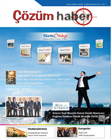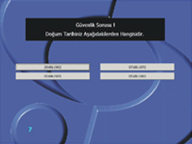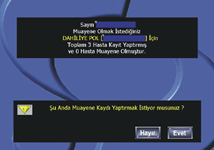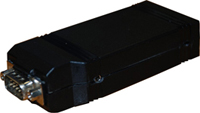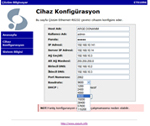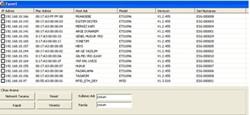Our R&D Hardware Products are being fully produced by Çözüm Bilgisayar Engineers in Turkey. Our products are for hospital based use and can be customized for special purpose using.
BRIEFLY OUR PRODUCTS
Our RFID products can be used for Access Control, Personnel Attendance Control and Queue Paging System. Our Kiosk System, compatible with HIS/HIMS, enables taking a queue number by oneself. This system provides convenience for the hospitals. Our Ethernet Terminal Server, providing to communicate with every device in serial port (com) on Ethernet, enables a great convenience for the users. For example; in the laboratories, each device require a PC. But; using an ETS for each device, it is possible to send data to a computer.
OUR RFID PRODUCTS
Personnel Attendance Control System: Users use that cards in working hours while entering or leaving. The working hours of the user can be reported daily, weekly and monthly where the user is.
All the information transmitted via the system such as working and charging information, information that will be the reference and basis points for the payrolls, or all the reports (late comers, early leavers, overtime workers, absents etc.) that measures work time efficiency such as overtimes, late entrance, early leave, leaves and time measurements are recorded in the system. The system provides unlimited means regarding the issues of measuring and controlling institutional work efficiency. Apart from the activity of controlling the entrance and exit of the personnel, the system enables the follow-up regarding whether the working hours are spent in an effective manner or not by means of the process controls. It provides a control and measurement mechanism concerning the lunch and resting and timeouts.
The reliability of the identification cards that are press printed on th PVC surface, is maintained by means of the press print and the photographs. The magnetic stripe identification cards contain very limited key information such as the name and surname of the card owner. On the other hand, the RFID Cards, provides a securer structure, compared to other cards, that is specially designed in conformity with multipurpose use, apart from the high information storage capacity (it can store a hundred times more information than the magnetic cards). In addition to the ability to be rewritten and re-used, the card has a durable structure that does not get affected by the unfavorable environmental conditions (water, magnetic field etc.). The system provides protection from the unauthorized access, imitation and copying. Moreover, it does not require physical contact and provides an ease-of-use.
Since the system operates with Çözüm Personnel and Employee Module in an integrated manner, all of the information (Personnel List, On-duty list, Title Registry Number and Identification Information etc.) can be accessed immediately. All of the personnel information can be controlled or searched via the system. Establishing another software or interface is not required to conduct the mentioned activities.
The system eliminates the failures and time losses that will come out in the enterprises with a high number of employees due to the manual work process follow-ups. While the elimination of the manually-handled activities, file and document archives and and the time losses, resulting from the effort to access this information when necessary diminishes the rate of failure in all activities, the rate of accuracy and the activity speed rises steeply. The system facilitates the personnel follow-ups especially for the health enterprises that employ a high number of personnel.
The LCD monitor positioned on top of the reader digitally displays the activities made by the users and creates an interface for the user. When the card of the user is read, the LCD monitor displays the registered name together with the card number. The monitor displays the date and the time; as the card is read, the monitor displays the identification information and displays messages like; Welcome to RFID System, Dear.........., You Entered, Dear.........., You Left etc.; if there comes out a system communication error, the monitor displays the warning: The message of "A communication error occurred” appears and it changes its status to off-line. It isn't possible to make an operation with the same card again.
Dining Hall Follow-up and Access Control System: Dining Hall Follow-up System works with the adaptation of Mifare Card Reader with the tollgate. It is possible to limit user access. The users can only access with a permission. For instance; the personnel can only pass from the tollgate all day long when it is allowed and if they have the right of access and meal. If not; they can not pass. The access is only for one person. It is possible to report all the meals in this system daily, weekly and monthly.
In door entrance and exit; in access points like tollgate, it provides a secure access control in the units like dining hall and surgery room. Mifare Card Access System is compatible with all access points and witj shift and shiftless working periods
The system works with the same functioning in surgery rooms and in other units. The one who has not the right of access, can not open the surgery room door.
Polyclinic Queue Paging System: This system is being used with Mifare Card Readers that are positioned on polyclinic doors and patient cards. The patients' ID Numbers are written on these cards. The patient that wants to go to any polyclinic, he/she uses the card reader on that door. After the provision, he/she can take a queue number with his/her ID Number.
Kiosk Queue Paging Sytem
Çözüm Kiosk System enables patients to take a queue number for the polyclinic and the doctor that they want to see without needing the help of the people in charge in the desk and to take consideration for their bills from the social security institutions they are member of.
The system enables patients who applied to a health organization to complete registry and approval activities quickly and to get service without waiting in the queue.
System is being currently used in 30 hospital.
By means of Çözüm Kiosk System, all the patients can make appointments without using classical appointment. Taking a queue number, they can go to the polyclinic where they will be examined. Çözüm Kiosk
It enables the provision operations, which are compulsory in our country for the examination registry of the social security institution member patients, to be made without employing human power. Immediate and real time provision obtained and registration activities completed quickly using Çözüm Kiosk System minimizes the time period for the patient to access to the doctor.
The system prevents the patients whose premiums have not been paid to make registrations, the unfair queue forms due to individual initiatives and all types of abuse of rights. If the patient can't get a provision number, in case of the institutions that ask for a provision number, the system doesn't let the patient to select polyclinics and asks the patient to apply to the institution.
Showing the charts of administrative units, it is possible to get information about administrative structure of corporation/institution over interactive introductory videos and for patients to find the places that they are searching. Guide charts and animations enable patients to find easily their way, without asking to another people and losing time, especially in complex healthcare corporation/institutions.
While enabling the patients to complete registration in a short period of time that the patient spends at the hospital, the system as well improves the service quality making the service periods to be used in a more efficient way.
In the polyclinic selection interface of the Kiosk System, the patient can see the name of the doctor together with the names of the polyclinics. For the polyclinics in which more than one doctor operates, the patients are able to choose the doctor that they want to see.
Time limiters are applied in the Kiosk System in order to prevent the patients to extend the activity period and lead to delays in the activities of the patients waiting.
Within the kiosk usage report, it is possible search the queue numbers that the patients got/couldn't get, the patients that got a queue number from the Kiosk and got examined/ but could not get examined for the selected days and time periods, the people who gave wrong answers to the security questions etc. and other searches for service, doctor and user file numbers or activity number.
With the kiosk usage statistics report, queue numbers given on the basis of polyclinic and the desks and kiosks that gave those queue numbers can be listed using a statistical method.
Kiosk system can be expanded with additional units such as the magnetic information entering units (RFID, barcode reader). Keyboard, mifare card readers. By means of the kiosk system that operates with Çözüm Personnel and Employee System in an integrated manner, the entrance-exit controlling activities in operation rooms and dining halls can be made in a secure and quick way. Since it is structured on an advanced computer system, it covers all advantages and features introduced by the usage of computers.
The personnel, working in the health institution, lets the card reader (RFID, Barcode) on the kiosk system read the personnel card (PVC card with barcode, magnetic card, mifare card, etc.) granted to make both the entrance and exit activities. Since Çözüm Kiosk System operates with Çözüm Personnel and Employee Module bin an integrated manner, the registrations take place online
If the patient does not have any document the barcode of which can be read by the reader, he/she uses the keyboard on right bottom of the screen (enters the file number and then presses ENTER) and starts the entry preocess.
After these activities are held, administrative staff (chief doctor, doctors) can see the list of late comer and early leaver staff and the performance results of these staffs and can conduct performance evaluations inaccordance with these results
(Wrong Entry Number! Please Type Again!)
If the patient enters the wrong number three times one after the other, the file number of the patient is blocked preventing the patient to continue the processes and a warning message is displayed.
(Your Kiosk access is blocked! Please apply to the information processing department!)
If the entry process is completed successfully, the confirmation page is displayed. Identification Number, File Number, Name and Surname of the patient and the name of the institution is displayed on this new page and the patient is asked to confirm this information.
After YES choice, the patient is directed to the window where the security control is held.
On this window, one of the private information provided is asked to the patient with the purposes of security and the correct answer is asked to be selected among the four options (The information recorded in the card such as Date/Place of Birth, Parents' name etc.). If the correct answer is not selected, the system returns to the main page and asks the patients to pursue first entrance. If the correct answer is selected, the patient is directed to the next stage, Polyclinic Selection Window.
The patients select the polyclinic that they want to be examined in on the polyclinic selection window. If the doctors will operate during that day are pre-specified, names of the doctors are as well displayed in the Polyclinic Selection Window.
The polyclinics with full capacity, the ones who are organized to accept patients only via getting a queue number from the information desk or the polyclinics out of service are displayed passive. If the polyclinic, wanted to be selected, is passive the system does not let the selection. In this case, the GO BACK key can be pressed to end the operation and turn back to the first entry page.
If the patient selects one of the active polyclinics (the system does not let one patient to take two queue numbers for one polyclinic in the same day), the polyclinic information window is displayed. This window, with the name of the polyclinic that the patient wants to apply to, the number of the patients registered during the day and the number of the patients who got examined up to that time. With the help of these notices, the patient learns how much more he has to wait to be examined.
Do you want to complete the examination registration now ?
If the patient responds no, the operation is ended and the system is reset to the initial entrance window. If the patient responds yes, the provision (bill control) search for the patient whose identification information is gathered, is held for the case of the health institutions that require such provisions. If the respond to the search was negative, the following warning message is displayed.
The institution that you are the member of did not approve the provision.
The system returns to the main page. If the respond is positive, the Identification Number or Name and Surname of the patient and the name of the institution are displayed on the window.
“The provision searching activity is completed successfully.”
The patient is directed to the confirmation window. On the confirmation window, Identification Number of File Number, Name and Surname of the Patient and the Name of the Institution is displayed, the patient is asked to confirm
Operation will be continued for the patient the information of whom is written above! Do you want to continue?
is displayed. If the patient enters NO, the system resets; if the patient enters YES, the system opens the final window. Displaying the patient information as header, the final window reports for which polyclinic the patient got which queue number.
You are registered to the internal diseases polyclinic with the queue number [**********] 55. Please take an examination number.
As the final step, the examination label is written.
"The operation is completed after the patient clicked OKEY key, or via automatic timing system. The information of the operation that became valid after the confirmation is printed with a point-print or thermal printer, as the queue number barcode label. The Kiosk device is enriched with the additional units
Kiosk system can be expanded with additional units such as the magnetic information entering units (RFID, barcode reader). Keyboard, mifare card readers. By means of the kiosk system that operates with Çözüm Personnel and Employee System in an integrated manner, the entrance-exit controlling activities in operation rooms and dining halls can be made in a secure and quick way. Since it is structured on an advanced computer system, it covers all advantages and features introduced by the usage of computers.
Ethernet Terminal Server
As is evident from it's name; this device enables the device communication on Ethernet (TCP). The desired baud rate can be adjusted. It has a web interface. It is possible to make the required adjustment and to take an IP from DHCP.
It is possible to scan ETS with the help of small but useful ETS.EXE program. We can use them, making the required modifications.
It provides a big convenience for laboratory devices currently being used in our hospitals. A PC was being used for each device. But owing to this device, it is possible to connect several devices with just one computer. It can be used for all devices that communicate with serial port. It makes a great saving of cost and manpower.
HPATIENT MEAL FOLLOW-UP SYSTEM
MThe patient meal follow-up is possible with Mobile RFID Technology. It informs that which patient eats normal meal and which one eats diet meal owing to RFID Cards. It keeps the meals of hospital attendant. Besides, it can report daily, weekly and monthly, which patient and which hospital attendant eat normal meal and which one eats diet meal.
MOBILE MIFARE CARD READER
| Processor | 32 Bit Arm7 MIPS75 |
| Reading Distance | 3 - 5 cm |
| Recording Capacity | 8195 kart ID |
| Act Capacity | 67000 activity |
| Memory | 2MByt Flash, 64 KByt nvra, SD falsh max 2GB |
| Card Recognition Method | ISO 1443A/B Protocols |
| Communication | 1 USB 2.0, 1 RF 868 Mhz, 1 GPS (optional) |
| Running Heat Range | -30ºC and +75ºC |
| Size | 185x118x37 mm |
| Screen Type | 2” Renkli TFT Screen |
| Keyboard | 4x4 matrix 16 Key aided |
| Battery | 3.7 Volt 700-800 mA Lithium ion battery |
| Power Consumption Range | 50 – 700 mA |
| Voltage Protection | Yüksek Voltaj Koruması |
| RTC(Real Time Clock) | Battery aided |
| Input/Output | 1 TTL output |
| Compatible Card Types | All Mifare Cards |
2D DATAMATRIX, VACCINE, ANTI-SERUM TEMPERATURE TRACKING
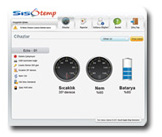
It is stated in 16.05.2011 dated and 21878 numbered letter of Ministry of Health General Directorate of Treatment Services on data matrix application that equipments specified for data matrix vaccine stock tracking system must be immediately provided.
Temperature Tracking Program and Hardware stated in paragraph C of related letter can be provided by our company.
SisoTEMP can be used not only for vaccine chambers temperature but it also has many usage areas such as Computer System Chambers, Laboratory Kits and Blood Banks where temperature tracking is of high importance.
What is SisoTemp application?

Devices are designed to measure temperature of ambient where vaccine and antiserum chamber or boxes are located. Besides, it has various usage areas. It has many usage areas such as Computer System Chambers, Laboratory Kits and Blood Banks where temperature tracking is of high importance. Device can provide necessary report temperature values to a computer over Tcp/Ip. Device settings can be operated via web service and it has a useful and practical interface.
Device has two versions; cabled and wireless. Device type can be altered according to purpose of use. Our devices are design in accordance with the regulation of Ministry of Health and put into service of users by subjecting it to necessary calibration.









